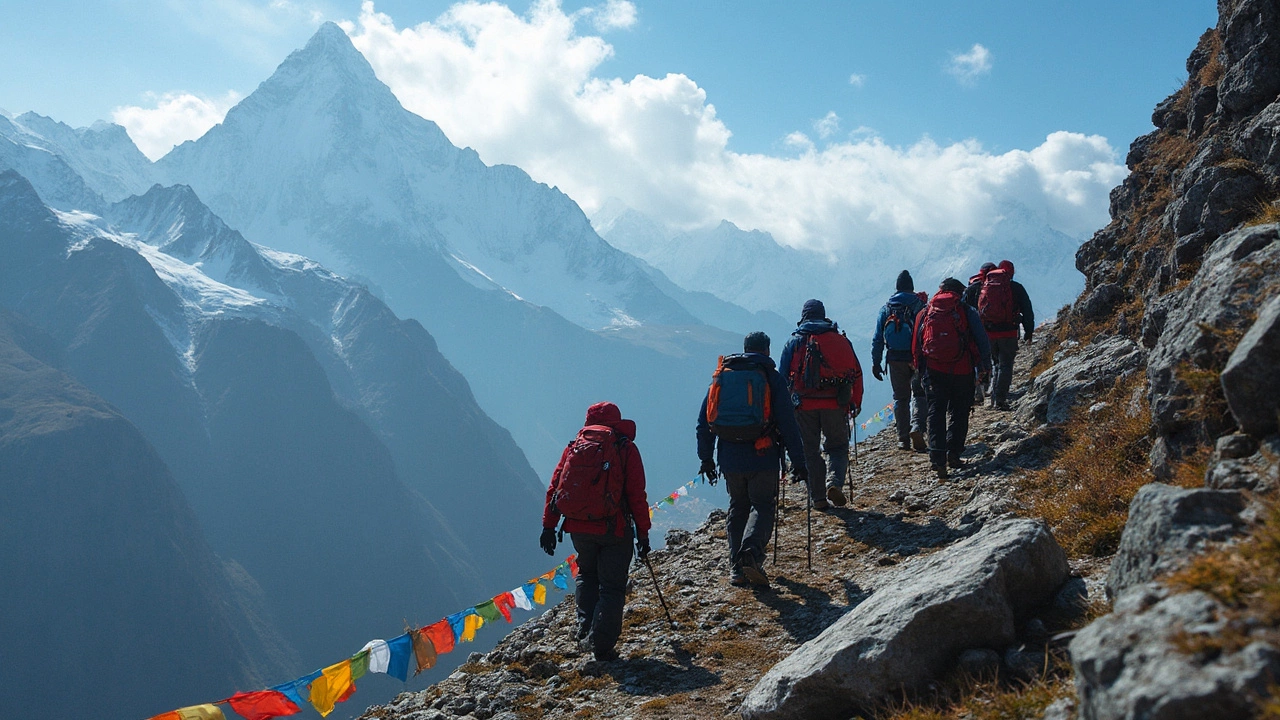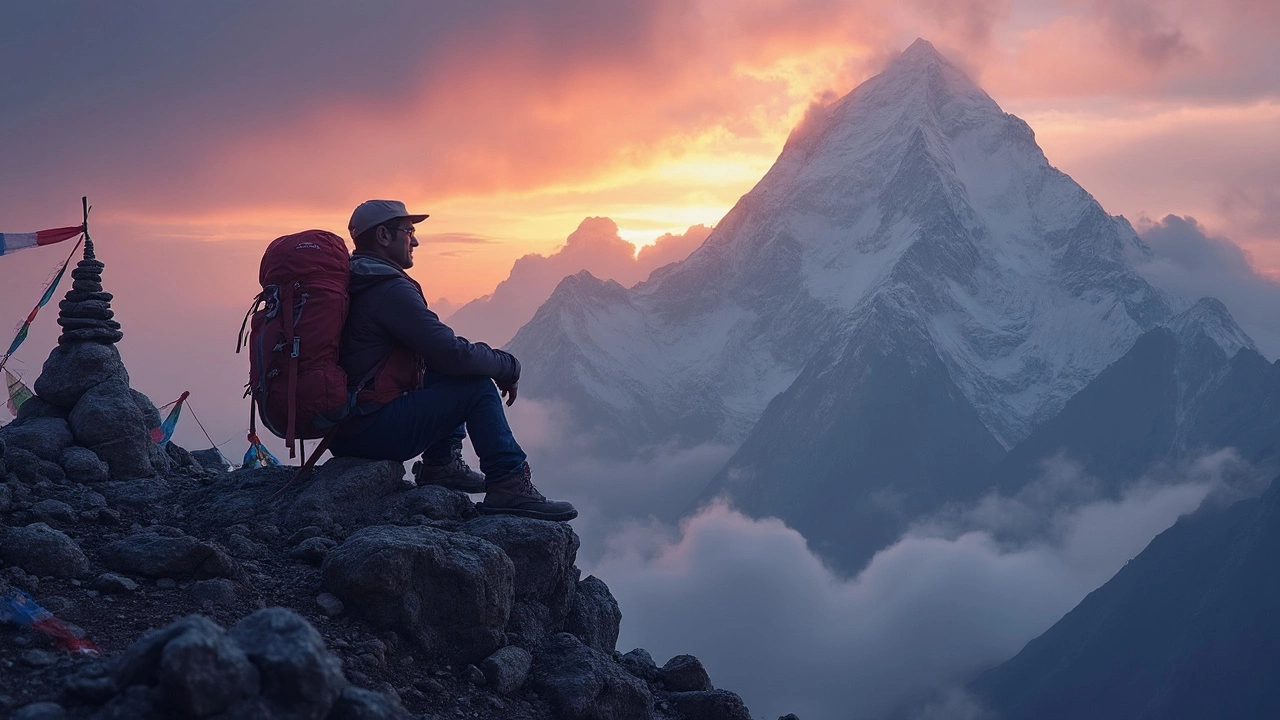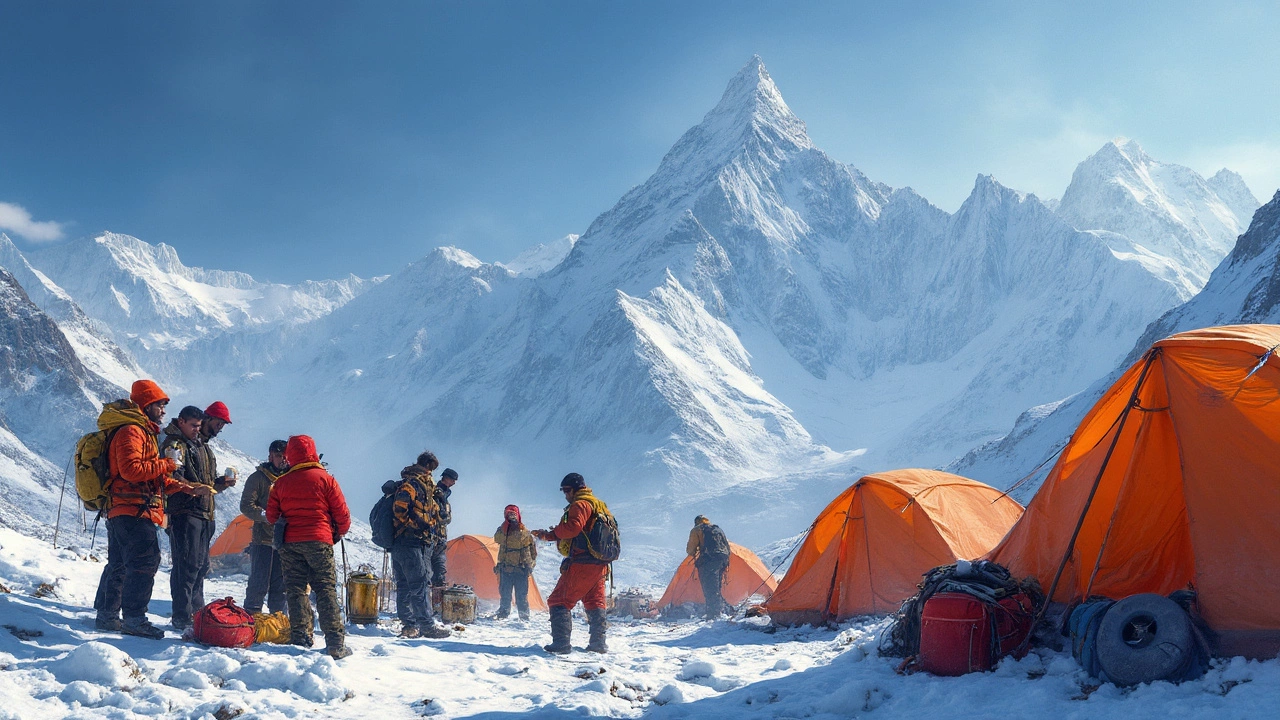Tallest Trek in India: Where to Find the Highest Adventure

- Jun, 10 2025
- 0 Comments
- Aaron Blackwood
You want to know which trek in India stands the tallest? That’s Kangchenjunga Base Camp—no contest. Tucked away in Sikkim right on the Nepal border, this trek takes you to a breath-snatching 5,143 meters (16,873 feet). Compare that to popular spots like Everest Base Camp in Nepal, and you’ll see just how wild the altitude gets here in India.
People know Kangchenjunga as the third-highest mountain in the world, but the trek is way less crowded than those classic Instagram circuits. This means raw mountain vibes, way fewer trekkers, and unfiltered Himalayan views. It’s not for beginners—this trek will push your fitness and mental grit. But the bragging rights? They’re solid gold. If your trekking bucket list calls for ‘the highest in India,’ this is exactly where you’ll find it.
- Kangchenjunga Base Camp: The Tallest Trek
- How Tough Is the Climb?
- What Makes It Different from Other Treks?
- Essential Tips for High Altitude Trekkers
- Real Stories: What Trekkers Wish They Knew
Kangchenjunga Base Camp: The Tallest Trek
If you’re trying to find the highest trekking spot that India has to offer, Kangchenjunga Base Camp stands out by a mile. The trek takes you to around 5,143 meters (16,873 feet), putting it squarely at the top when it comes to altitude in India. It’s not just the tallest; it’s also one of the most raw and remote trails in the country.
Kangchenjunga itself is the third-highest mountain in the world, but reaching the base camp is a real adventure compared to more commercialized spots. The trail starts from Yuksom, a small town in Sikkim, and stretches over about 90 kilometers round trip. Most folks complete it in 10 to 12 days, with stops at Tshoka, Dzongri, and Laxmi Pokhari before you get to the actual base camp area.
This isn’t a trek you can just wing. Permits are mandatory, and you need to travel with a registered local guide or agency, since independent trekking isn’t allowed in Sikkim. That’s partly because of how close the area is to international borders and also to protect the region’s delicate ecosystems. Sikkim is strict about conservation and keeping trekking groups small, so you won’t be stuck in a crowd.
- tallest trek India tops every serious trekker’s bucket list and Kangchenjunga Base Camp is the only one in India that gives you that real rooftop-of-the-country vibe.
- Best time to hike? Mid-April to early June or late September to November—this avoids the wild monsoon rains and freezing winter blizzards.
- The route winds through forest, meadows, rhododendron valleys, and finally brings you up close with dramatic glaciers and Kangchenjunga’s massive face.
- Altitude sickness is a real threat here, so proper acclimatization is not optional—most guided itineraries build in extra days for just this reason.
With less infrastructure than places like Everest Base Camp, expect no internet, super basic tea houses, and a real sense of wilderness. But that’s what makes it stand out—it’s the tallest, and one of the truest treks you’ll find in India.
How Tough Is the Climb?
If you’re thinking of tackling Kangchenjunga Base Camp, don’t expect an easy walk in the park. This isn’t a touristy hill stroll—it’s the tallest trek in India for a reason. The altitude is a big deal: the trail peaks at 5,143 meters (about 16,873 feet). You’ll feel every meter of it, especially on the cold, thin-air nights where even tying your boots feels like a workout.
The trek usually takes 18-22 days, including days to acclimatize properly. That’s almost three weeks of moving through serious mountain terrain, rough paths, and unpredictable weather. Missing those rest days isn’t an option. Rushing the route has landed plenty of trekkers at the medical tent with altitude sickness.
The Kangchenjunga route isn’t flat or forgiving. Expect steep ascents, rocky trails, and long days that can stretch 7-8 hours. You’ll cross glaciers, fast rivers, and sometimes tricky snow patches. And you won’t find fancy tea houses everywhere—some nights are proper Himalayan camping. It’s remote, so forget about a quick rescue if something goes wrong.
"Kangchenjunga is breathtaking—literally and figuratively. The trek demands proper acclimatization, good stamina, and real respect for the mountain." – Rimo Expeditions guide, 2024
Here’s a quick look at what you’re signing up for:
| Detail | Fact/Stat |
|---|---|
| Total Distance | 90-100 km round trip |
| Highest Point | Goecha La (5,143 meters) |
| Days Needed | 18-22 (including acclimatization) |
| Typical Weather | -10°C (night) to 12°C (day) |
| Descent Rate | ~500 meters/day during return |
If you’re physically fit, can handle long multi-day hikes, and have some high-altitude experience already, you’ll manage. But training counts big time. Most outfitters recommend at least two months of serious cardio and leg workouts before setting out.
- Train on steep stairs or hills at least 3 times a week.
- Carry a loaded backpack to mimic real conditions.
- Learn how to spot and handle altitude sickness—it can creep up fast.
This isn’t the place to ‘wing it.’ Respect the climb, gear up right, and always check in with your guide if something feels off. The mountain’s tough, but the payoff is something you’ll talk about for the rest of your life.

What Makes It Different from Other Treks?
If you compare the Kangchenjunga Base Camp trek to other famous Indian hikes, a few things separate it from the rest. First, there’s the pure height. This is the tallest trek in India, so altitude sickness isn’t just a possibility—it’s a real risk. Altitude gain happens fast and kicks in around Dzongri. You need both good stamina and serious mental grit.
The usual tourist crowds? Nowhere in sight. The Sikkim government actually limits trek permits and requires you to hire a local guide. That means the whole experience feels less commercial and more raw. No tea houses lining every stop like you find on Annapurna or Everest Base Camp in Nepal. Instead: old-school camping, basic food, and tent toilets. You’re really out there, depending on your crew and what you carry.
Another difference: Kangchenjunga’s trails cut through what used to be ancient trade routes. The way shifts from thick, shadowy forests to alpine meadows and then punishing rocky slopes near the base. You’ll pass small mountain villages, Buddhist stupas, and monasteries. No Starbucks, no boutique hotels, no Wi-Fi. The show’s all-natural. Here’s a quick look at how it stacks up against other top Himalayan routes:
| Trek Name | Max Altitude (meters) | Region | Average Duration | Type |
|---|---|---|---|---|
| Kangchenjunga Base Camp | 5,143 | Sikkim | 18-22 days | Camping, Offbeat |
| Stok Kangri | 6,153 | Ladakh | 8-10 days | Expedition, Summit |
| Roopkund Trek | 5,029 | Uttarakhand | 7-8 days | Camping, Meadows |
| Goechala Trek | 4,940 | Sikkim | 10-11 days | Camping, Forests |
One last thing: this trek isn’t about rushing to the finish. Weather here is a beast—sudden snowstorms or heavy rains can slow you down by days. You’re walking into a conservation zone, not just a mountain trek. The region is home to red pandas, blue sheep, and rare birds. That’s why the government is strict about eco-friendly trekking. Carry out your trash, use bio-degradable soap, and forget campfires—they’re not allowed. All these little rules and the need for real prep keep things very different from popular, commercial trails.
Essential Tips for High Altitude Trekkers
If you’re thinking about tackling the tallest trek India has to offer, there’s a lot more to it than just good shoes and a jacket. High altitude trekking can mess with you if you’re not ready, so here’s what you need to know.
- Go Slow, Always: Your body needs time to get used to less oxygen. Take it steady, even if you feel pumped on day one.
- Hydration Is Not a Joke: Drink at least 3–4 liters of water daily. Dry mountain air makes you lose water way faster.
- Eat Carbs: Eating carbs helps your body use oxygen better, which is legit science. Don’t skip meals even if you lose your appetite.
- Know Acute Mountain Sickness (AMS) Signs: Headache, nausea, dizziness, and trouble sleeping are red flags. Don’t try to tough it out—let your guide know fast.
- Acclimatization Days Matter: Stick to a schedule that includes rest days, especially above 3,000 meters. One bad decision can end your trek.
- Skip Alcohol and Smoking: At altitude, these are basically energy thieves. They mess up your sleep and hit your stamina hard.
| Symptom | % of Trekkers Affected (Above 3,500m) | When to Take Action |
|---|---|---|
| Headache | 85% | Stay hydrated, slow down. Severe? Tell your guide. |
| Nausea | 55% | Rest, drink water. Persistent? Assess for AMS. |
| Trouble sleeping | 60% | Normal at altitude, but talk to your group if ongoing. |
| Dizziness | 40% | If it doesn’t pass with rest, descend if needed. |
It’s also smart to pack basic meds, including paracetamol and something for nausea, just in case. And keep your insurance and emergency contacts written down somewhere other than your phone. Gear-wise, don’t cheap out on layered clothes and a sleeping bag rated for sub-zero. The top of the trek gets brutally cold, even in May or June.
Last tip—never ignore your body. If you feel off, speak up. On these big mountains, honesty literally keeps you safe.

Real Stories: What Trekkers Wish They Knew
Ask folks who've done the Kangchenjunga Base Camp trek and you’ll hear: it isn’t just about being fit, it’s about being prepared for the unexpected. Most people found the altitude hit much harder than expected—one guy had trained for months but still lost his appetite and couldn’t sleep above 4,500 meters. If you usually trek in Uttarakhand or Himachal, Sikkim’s weather feels different: it changes fast and gets bitterly cold at night even in May.
A lot of trekkers said they underestimated the remoteness. You can’t just grab a chocolate bar or paracetamol at a shop—there aren’t villages after a point, and the tea houses are basic. A good headlamp, extra snacks, and a solid power bank can save your trip. Someone shared he had to borrow a phone charger and got lucky; next time, he promised, he’d pack two.
Acute mountain sickness (AMS) is real here. A few folks had to turn back because they pushed too fast. One group split up—half of them made it to the base camp, while the others couldn’t cross the passes because of poor acclimatization. Here are the symptoms trekkers flagged as warning signs: headaches, nausea, dizziness, and no appetite. If even one creeps in, don’t try to power through, just rest.
- Always plan an extra acclimatization day past Dzongri to avoid AMS.
- Bring cash—cards and UPI are useless after Yuksom.
- Buy boots one size bigger, your feet will swell by day four.
- Filter or boil all water, don’t trust taps, even at tea houses.
Here’s a quick look at some real data from past trekkers and guides about their “wish I knew” moments:
| Aspect | What Surprised Trekkers | How They'd Prepare Now |
|---|---|---|
| Altitude Effect | 56% felt dizzy or nauseous above 4500m | More acclimatization, carry Diamox |
| Weather | 68% didn’t expect sudden hailstorms in May | Pack rain gear—always |
| Connectivity | Zero phone signal past Tshoka | Carry a satellite messenger |
| Food | Most found tea house food repetitive | Bring energy gels and protein snacks |
If you're set on taking on the tallest trek India has to offer, treat every tip here as non-negotiable. While standing at base camp feels epic, the real win is getting back safe with a story you want to tell again and again.